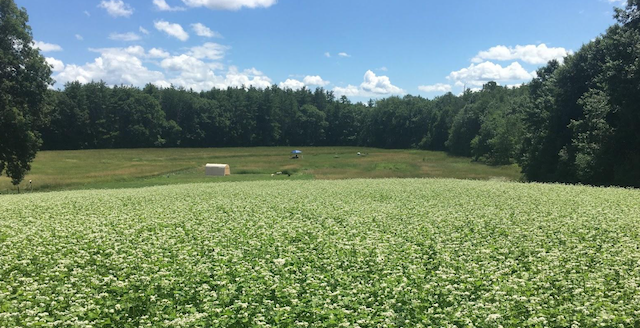Many Agrarian Commons farmers sow their fields with buckwheat, peas, clover, rye, and other cereals and grasses throughout the year. This technique, known as cover cropping, provides a number of benefits to the farmer’s land, including increased nitrogen levels, reduced soil erosion, weed control, and improved soil structure. However, caring for their own land isn’t the only reason these Agrarian Commons farmers practice cover cropping. According to the latest climate science, cover cropping has the potential to act as a critical tool in the fight against the greatest existential threat facing life on Earth—climate change.
What do peas and Agrarian Commons have to do with climate change? To get to our answer, we need to start with the causes and consequences of climate change.

In the past 50 years, global carbon emissions have almost doubled. As carbon accumulates in the atmosphere, it acts as a greenhouse gas, trapping in the sun’s heat near the earth, and preventing heat from escaping into the surrounding space. This greenhouse effect has already increased global temperatures by 1 degree Celsius since 1900. While this temperature shift may seem small, it has already had tragic consequences around the world. It’s worth remembering that one-third of Pakistan went underwater in June 14, 2022.
Farmers are in a critical position to accelerate the process of soil sequestration, while ensuring that the carbon remains locked in the soil.
Climate scientists have issued countless reports, including the International Panel on Climate Change’s 2022 Sixth Assessment Report, urging nations to drastically reduce their carbon emissions. If temperatures rise above 1.5 degrees Celsius compared to pre-industrial levels, they warn, there will be dire consequences for Earth’s ecosystem including extended drought, wildfires, flooding, and collapsed ecosystems. Unfortunately, these warnings have gone largely unheeded.
The good news is, while emissions reduction is still the most important way to mitigate climate catastrophe, there is a growing body of evidence that shows that carbon can be removed from the atmosphere—and stored in soil. This process, known as soil sequestration, is being championed by farmers, climate scientists, and nonprofit organizations, including Agrarian Trust, who see it as one of our most valuable tools in the fight against climate change.

When Agrarian Commons farmers plant cover crops and practice techniques such as low, or no-till agriculture, they create the conditions that enable carbon to be sequestered and stored in soil.
For the most part, carbon enters the soil naturally. As plants grow, they convert carbon in the atmosphere into organic matter. When plants die, they decompose and distribute this carbon to the thriving microbial and fungal communities. Carbon can be stored, or more accurately, recycled, through this, and other natural processes for long periods of time without being released into the atmosphere. Scientists estimate that Earth’s soil has the capacity to sequester over a billion tons of carbon each year. As stewards of 38 percent of Earth’s land mass, farmers are in a critical position to accelerate the process of soil sequestration, while ensuring that the carbon remains locked in the soil.
Running a farm doesn’t necessarily mean you’re sequestering carbon, however. In fact, it’s been estimated that as many as 110 billion metric tons of carbon have been released into the atmosphere through agriculture in the past 12,000 years. Much of this loss can be attributed to conventional farming techniques that disturb or expose soil. When conventional farmers prepare for the growing season, for example, they till their fields, breaking up soil to allow air and water to penetrate the ground. This might seem reasonable at first, but it actually destroys the soil’s structure, causing carbon to be released into the atmosphere. Other conventional farming techniques, such as leaving a field exposed at the end of the season, may cut down on operation costs in the short term, but in the long term can lead to carbon loss by leaving microbial communities exposed to the elements.

The practices that enable farmers to sequester carbon, on the other hand, protect and preserve soil structures. According to a 2022 report by American Farmland Trust (AFT), the two most effective techniques farmers can use to sequester carbon are cover cropping and no till. These techniques are also associated with the practice of regenerative farming, which seeks to not only preserve soil, but to actively restore the soil’s health.
The two most effective techniques farmers can use to sequester carbon are cover cropping and no till.
Cover cropping enables soil sequestration in a couple different ways. First, by planting a crop during a season where the field would be exposed, farmers can increase the amount of organic matter that enters the soil, leading to higher levels of carbon in the soil. Second, the cover crops create a protective cover over the soil, enabling microbial communities to thrive. “When these microbes die,” the report explains, “their bodies break down into [carbon] rich compounds that adhere to soil particles (e.g., silt, clay). The combination of active roots and sticky microbial compounds hold the soil together in small clumps called aggregates, which are resistant to disturbance by wind, rain, and tillage.” The soil aggregates in turn prevent carbon dioxide from being released into the atmosphere.
No till is another critical means of preserving soil structure. The AFT report defines no till as, “a system of establishing annual crops without disturbing the soil (i.e., tillage) prior to planting.” Unlike conventional tillage-based farming, no-till farming involves planting seeds directly into undisturbed soil. This preserves the soil structure and allows carbon to accumulate in the form of soil aggregates. There are similar techniques that maintain some of the benefits of tilling, while minimally disturbing the soil. Strip tilling, for example, involves shallow tilling in narrow strips where seeds will be planted.
According to AFT, the implementation of no-till and cover-cropping practices has the potential to sequester up to 246 million metric tons of carbon annually, or roughly 40 percent of the agricultural sector’s total emissions.

Agrarian Trust supports the expansion of no-till and cover-cropping practices by connecting regenerative farmers with affordable, long-term access to land. By combining the best of conservation and community land trust models in the Agrarian Commons, Agrarian Trust guarantees that farmers will have the support they need to implement the latest regenerative farming practices. Agrarian Commons leases uphold soil health as a top priority, meaning that many Agrarian Commons farmers routinely practice no-till and cover-cropping techniques.
No matter how much land is divided, bought, and sold, it will always be interrelated with its surroundings, and the planet as a whole. When Agrarian Commons farmers plant cover crops, they are supporting farmers across the world by reducing the impact of climate change. While this is only a small drop in what will need to be a much larger, and more widespread implementation of no-till and cover-cropping practices, providing regenerative farmers with – affordable long-term access will play a key role in combating climate change through soil sequestration.




